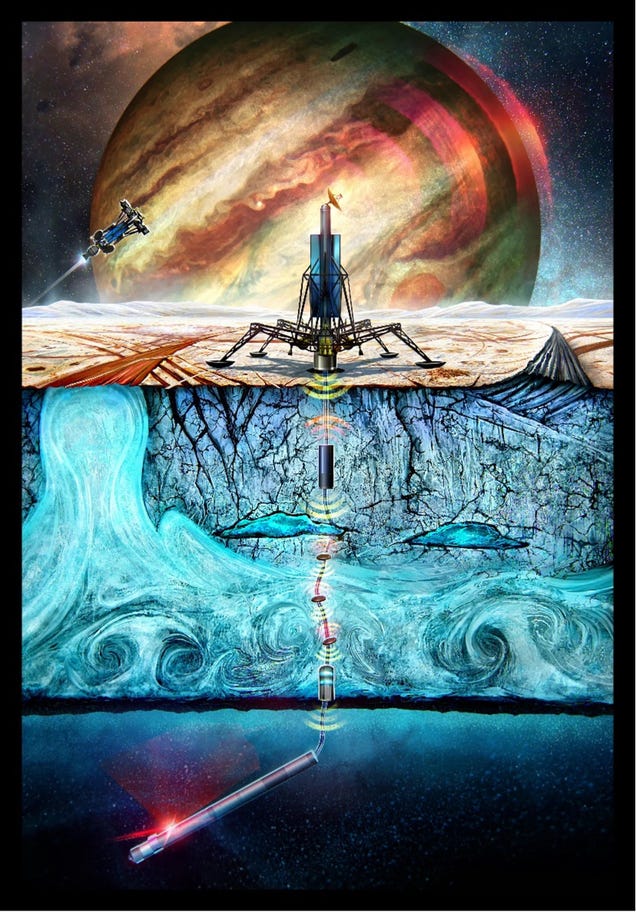Astrobiologists suspect there could be alien life just out of reach in our solar system, in oceans hidden beneath icy crusts on moons circling Jupiter and Saturn. But unlike the surface of Mars, which can be explored by rovers and landers, these mysterious oceans are currently inaccessible to us. In an effort to change that, researchers convened this year to design a novel mission that could finally reveal what’s in those distant water worlds.
The proposed probe, called a cryobot, is a cylindrical robot that would be capable of heating up ice to drill through it, allowing the bot to access the liquid water ocean beneath. The workshop, held in February at the California Institute of Technology, brought together over 40 researchers to mature the technological concept. The participants explored the power, thermal, mobility, and communication systems necessary for such a mission, as NASA described in a recent article.
Scientists take seriously the idea that some form of life exists off Earth, and space observatories including the Webb Space Telescope and eventually the Habitable Worlds Observatory are designed to collect data on exoplanets where alien life could form. Those worlds, though, are much too far away for us to explore directly. Instead, our best hope is to look where liquid water likely exists in our solar system.

The concept would work like this: A lander would alight on a frozen moon and deploy a cylindrical probe to break through the icy surface using hot-water drilling. The cryobot would have a roughly 10 kilowatt nuclear power system that would be protected within a structure that shields it from the high pressure of the deep ocean.
A thermal management system would keep internal temperatures at a safe level and properly distribute the heat throughout the system. A water jetting and cutting system would be included in the device to allow the cryobot to clear rocks, particulate matter, and salt encased in the ice.
The workshop participants concluded that a demonstration of hazard mitigation systems is a high priority for future work on the concept.
They also determined that any cryobot deployed on a moon would need a communication link that allows it to transmit information to a surface lander, which in turn would relay that data to Earth. While fiber optic cables are an industry standard, NASA explained, movements in the ice shelf could cut off the connection between the lander and the probe, which could be kilometers beneath the ice. Wireless communication methods are on the table, including radio, acoustic, and magnetic transceivers.
Jupiter’s moon Europa and Saturn’s moon Enceladus are of particular interest for astrobiologists. NASA and ESA have committed missions to exploring Europa and developed a mission concept for visiting Enceladus. NASA’s Europa Clipper is expected to launch in October 2024, and its observations will inform the ideal design for a cryobot probe, which will need to breach the moon’s frozen surface and then relay data from the ocean beneath. The Enceladus Orbilander would orbit and then land on the Saturnian moon, looking for signs that the subsurface ocean could contain life. Earlier this year, a team of scientists found evidence that phosphorus, a key ingredient for life as we know it, was being belched up by Enceladus, whose water vapor plumes can be over 6,000 miles long.
The recent workshop participants concluded that the mission concept “remains feasible, scientifically compelling, and the most plausible near-term way to directly search for life in situ on an ocean world,” according to a NASA.
It will be years before we see a probe touch down on one of these icy moons, but we’re getting much closer to actually exploring an alien ocean.
More: Evidence of Life Could Exist Just Beneath Europa’s Icy Surface
